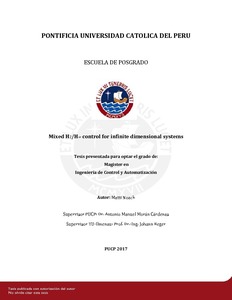| dc.contributor.advisor | Morán Cárdenas, Antonio Manuel | |
| dc.contributor.advisor | Reger, Johann | |
| dc.contributor.author | Noack, Matti | es_ES |
| dc.date.accessioned | 2017-08-28T23:02:47Z | es_ES |
| dc.date.available | 2017-08-28T23:02:47Z | es_ES |
| dc.date.created | 2017 | es_ES |
| dc.date.issued | 2017-08-28 | es_ES |
| dc.identifier.uri | http://hdl.handle.net/20.500.12404/9251 | |
| dc.description.abstract | The class of infinite dimensional systems often occurs when dealing with distributed
parameter models consisting of partial differential equations. Although forming a
comprehensive description, they mainly become manageable by finite dimensional approximations
which likely neglect important effects, but underlies a certain structure.
In contrast to common techniques for controlling infinite dimensional systems, this
work focuses on using robust control methods. Thus, the uncertainty structure that
occurs due to the discretization shall be taken into account particularly. Additionally,
optimal performance measures can be included into the design process. The mixed
H2/H∞ control approach handles the inclusion of disturbances and inaccuracies while
guaranteeing specified energy or magnitude bounds.
In order to include various of these system requirements, multi-objective robust control
techniques based on the linear matrix inequality framework are utilized. This offers
great flexibility concerning the formulation of the control task and results in convex
optimization problems which can be solved numerically efficient by semi-definite programming.
A flexible robot arm structure serves as the major application example during this
work. The model discretization leads to an LTI system of specified order with an uncertainty
model which is obtained by considering the concrete approximation impact
and frequency domain tests. A structural analysis of the system model relates the
neglected dynamics to a robust characterization. For the objective selection, stability
shall be ensured under all expected circumstances while the aspects of optimal H2 performance,
passive behavior and optimal measurement output selection are included.
The undesirable spillover effect is thoroughly investigated and thus avoided. | es_ES |
| dc.description.uri | Tesis | es_ES |
| dc.language.iso | eng | es_ES |
| dc.publisher | Pontificia Universidad Católica del Perú | es_ES |
| dc.rights | Atribución-NoComercial-SinDerivadas 2.5 Perú | * |
| dc.rights | info:eu-repo/semantics/openAccess | es_ES |
| dc.rights.uri | http://creativecommons.org/licenses/by-nc-nd/2.5/pe/ | * |
| dc.subject | Sistemas dinámicos | es_ES |
| dc.subject | Espacios dimensionales infinitos | es_ES |
| dc.subject | Control robusto | es_ES |
| dc.title | Mixed H2/H∞ control for infinite dimensional systems | es_ES |
| dc.type | info:eu-repo/semantics/masterThesis | es_ES |
| thesis.degree.name | Magíster en Ingeniería de Control y Automatización | es_ES |
| thesis.degree.level | Maestría | es_ES |
| thesis.degree.grantor | Pontificia Universidad Católica del Perú. Escuela de Posgrado | es_ES |
| thesis.degree.discipline | Ingeniería de Control y Automatización | es_ES |
| renati.advisor.dni | 10573987 | |
| renati.discipline | 712037 | es_ES |
| renati.level | https://purl.org/pe-repo/renati/level#maestro | es_ES |
| renati.type | http://purl.org/pe-repo/renati/type#tesis | es_ES |
| dc.publisher.country | PE | es_ES |
| dc.subject.ocde | https://purl.org/pe-repo/ocde/ford#2.02.03 | es_ES |






